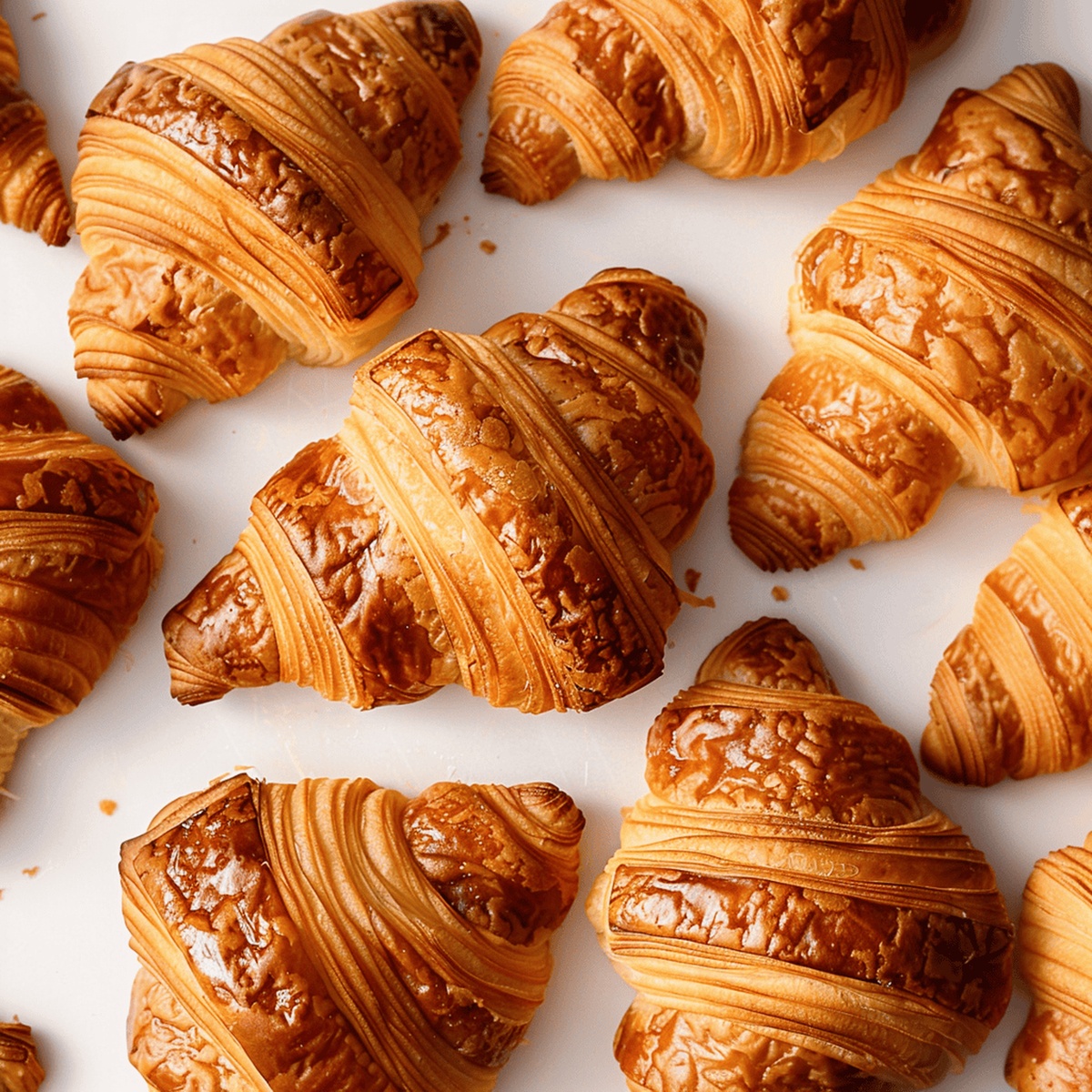Buttery Homemade Classic French Croissants Recipe
French croissants represent the pinnacle of buttery, flaky pastry craftsmanship that converts simple ingredients into culinary magic.
Bakers worldwide revere these crescent-shaped delights as symbols of precision and patience in baking.
Layers of delicate, golden dough demand meticulous technique and unwavering commitment from passionate culinary enthusiasts.
Each folded sheet creates a complex architectural marvel of butter and flour, promising an extraordinary sensory experience.
Professional pastry chefs understand that mastering croissants requires dedication, practice, and respect for traditional techniques.
Delicate lamination creates those signature gossamer-thin layers that shatter beautifully with each delectable bite.
Remarkable skill converts basic components into an extraordinary breakfast treasure that transports you to Parisian bakery bliss.
Tips for Proofing and Baking Perfect Croissants
Keeping Your Croissants Fresh and Fluffy
What to Pair with Buttery French Croissants
Unique Twists on the Classic Croissant
French Croissants and Their Classic Appeal
What Goes Into Classic French Croissant Dough
Bread Ingredients:Liquid Ingredients:Fat Ingredients:Instructions for Buttery Flaky Croissant Layers
Step 1: Prepare the Magical Dough
Gather these ingredients:In a stand mixer, combine ingredients and mix until a soft, smooth dough forms. Knead gently for a few minutes until the dough feels elastic and springy.
Step 2: Create the Butter Magic
Soften cold butter and blend with a touch of flour until creamy and spreadable. Wrap the butter mixture in parchment paper and shape into a perfect rectangle. Chill in the refrigerator until firm.
Step 3: Layer and Fold the Dough
Roll out the rested dough into a large rectangle. Place the chilled butter block in the center and fold the dough over like an envelope. Gently roll out and perform a series of precise folds to create delicate, thin layers.
Step 4: Chill and Rest the Laminated Dough
Wrap the folded dough and let it rest in the refrigerator. This allows the gluten to relax and the butter to firm up, creating those signature flaky layers.
Step 5: Shape the Croissants
Roll the chilled dough into a thin sheet. Cut into elegant triangles. Carefully roll each triangle from the wide base to the pointed tip, creating a classic crescent shape.
Step 6: Proof and Prepare for Baking
Let the shaped croissants rise in a warm, draft-free space until they look puffy and doubled in size. Brush with a light egg wash for a golden, shiny finish.
Step 7: Bake to Perfection
Preheat the oven to 425°F for an initial high-heat burst. Reduce temperature to 375°F and bake for 20-25 minutes. Watch for a deep golden-brown color and crispy, flaky exterior.
Step 8: Cool and Enjoy
Remove croissants from the oven and let cool on a wire rack. The aroma of freshly baked croissants will fill your kitchen with pure delight.
Print
Classic French Croissants Recipe
- Total Time: 1 hour 45 minutes
- Yield: 12 1x
Description
Buttery, flaky French croissants emerge from delicate layers of yeasted dough, carefully folded with rich European butter. Delightful pastries reward patient bakers with golden, crisp crescents that transport palates straight to Parisian bakery shelves.
Ingredients
Flour and Dry Ingredients:
- 5 cups (600 grams) bread flour
- ½ cup (60 grams) whole wheat flour
- ¼ cup (30 grams) bread flour
- ¼ cup (50 grams) granulated sugar
- 2–½ teaspoons (9 grams) instant yeast
- 1–½ teaspoons (10 grams) fine sea salt
Liquid Ingredients:
- 1 cup (227 grams) room temperature water
- ¾ cup (170 grams) whole milk
- 1 tablespoon heavy cream
- 1 egg yolk
Butter Ingredients:
- 1–¾ cups (395 grams or 3–½ sticks) very cold unsalted European-style butter, cut into ½” pieces
- 4 tablespoons (56 grams or ½ stick) unsalted European-style butter, softened, cubed
Instructions
- Prepare the croissant dough by combining ingredients in a stand mixer, mixing until the dough cleanly separates from the bowl’s sides.
- Knead the dough briefly on a work surface, then allow it to rise in a covered container for approximately one hour.
- Flatten the risen dough into a rectangular shape, wrap in plastic film, and chill in the freezer for a short duration.
- Create the butter block by blending cold butter with flour using a paddle attachment until achieving a uniform, smooth consistency.
- Transfer the butter mixture into a plastic bag, roll it to create an even thickness, and refrigerate until firm.
- On a generously floured surface, roll out the chilled dough and strategically place the butter block in the center.
- Carefully fold the dough over the butter, encasing it completely like an envelope.
- Gently roll the dough-butter package into an elongated rectangle, then execute a precise double fold technique.
- Refrigerate the laminated dough to allow the layers to set and stabilize.
- Repeat the folding process with a single fold, further developing the delicate, layered structure.
- After the final chilling, roll the dough into a thin rectangle and methodically cut into precise triangular shapes.
- Starting from the wide base, carefully roll each triangle towards its pointed tip, creating the classic croissant curve.
- Allow the shaped croissants to proof until they visibly increase in volume, indicating readiness for baking.
- Preheat the oven, initially blast with high heat, then reduce temperature to ensure a golden, crisp exterior and tender interior.
- Bake until the croissants transform into a rich, amber-brown color with beautifully pronounced, flaky layers.
Notes
- Butter quality matters tremendously, selecting European-style high-fat content butter ensures flakier, richer croissants.
- Precise temperature control during lamination prevents butter melting, maintaining delicate layered structure crucial for authentic texture.
- Overnight refrigeration allows dough to develop deeper flavor complexity and enhances overall croissant sophistication.
- Prep Time: 1 hour 15 minutes
- Cook Time: 30 minutes
- Category: Breakfast, Snacks
- Method: Baking
- Cuisine: French
Nutrition
- Serving Size: 12
- Calories: 300
- Sugar: 6 g
- Sodium: 200 mg
- Fat: 16 g
- Saturated Fat: 10 g
- Unsaturated Fat: 4 g
- Trans Fat: 0 g
- Carbohydrates: 32 g
- Fiber: 1 g
- Protein: 7 g
- Cholesterol: 50 mg


Alex Reed
Founder & Lead Content Writer
Expertise
Recipe Development and Testing, Culinary Education, Food Writing and Blogging, Sustainable Cooking Practices, Global Cuisine Exploration
Education
Johnson & Wales University
Le Cordon Bleu Paris
Alex Reed is an inventive chef and food creator with a passion for dishes that balance taste, health, and sustainability.
Trained at Portland Community College and holding an Advanced Pastry Arts certificate from Oregon Culinary Institute, Alex brings more than 10 years of practical culinary experience to every recipe he develops.
His background uniquely blends traditional cooking skills with modern, mindful eating principles. As the founder of Beard and Bonnet, Alex creates recipes that encourage readers to cook confidently.